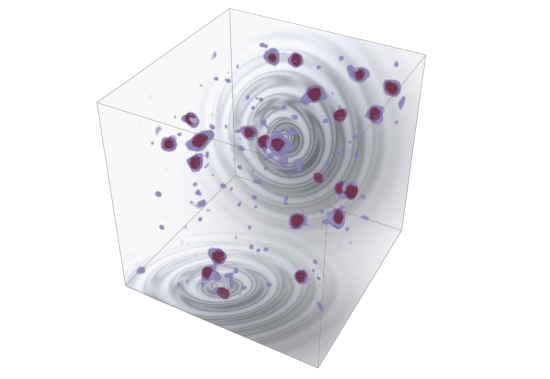Scientists have found a new generic production mechanism of gravitational waves produced by a phenomenon called oscillons. Several theories propose that these phenomena arise from the fragmentation into solitonic “lumps” of the inflaton field that directed the rapid expansion of the early Universe. This study was reported in a new study published in Physical Review Letters.
 Schematic of the inflaton field fragmented into oscillons, with superimposed gravitational waves. Image Credit: Kavli IPMU, Volodymyr Takhistov)Kavli. Institute for the Physics and Mathematics of the Universe
Schematic of the inflaton field fragmented into oscillons, with superimposed gravitational waves. Image Credit: Kavli IPMU, Volodymyr Takhistov)Kavli. Institute for the Physics and Mathematics of the Universe
The outcomes have paved the way for showing exciting new understanding regarding the earliest moments of the Universe.
The inflationary period is the moment that occurred following the Big Bang. The exponential expansion of the Universe is believed to be due to this inflationary period. In several theories of cosmology, the formation of oscillons occurs right after the quick expansion period.
Oscillons, a kind of localized non-linear massive structure, can develop from fields, like the inflaton field that are oscillating at high frequencies. Such structures can persist for long periods, and as scientists found, their ultimate decay can produce a considerable quantity of gravitational waves, which are ripples in space-time.
In their research, Kavli Institute for the Physics and Mathematics of the Universe (Kavli IPMU) Project Researcher Kaloian D. Lozanov, and Kavli IPMU Visiting Associate Scientist, International Center for Quantum-field Measurement Systems for Studies of the Universe and Particles (QUP) Senior Scientist, and High Energy Accelerator Research Organization (KEK) Theory Center Assistant Professor Volodymyr Takhistov, replicated the inflaton field evolution at the time of the early Universe and discovered that oscillons were present. Then, they found that oscillon decay could produce gravitational waves that would be detectable by forthcoming gravitational wave observatories.
The results offer a new test of the dynamics of the early Universe independent of the traditionally studied cosmic microwave background radiation. These gravitational waves’ discovery would demonstrate a new window into the earliest moments of the Universe and could aid in shedding light on a few of the pressing essential questions in cosmology.
With the continuing development of supercomputing resources and gravitational wave detectors, even more insight into the early moments of the Universe can be gained in the future. Altogether, the new research establishes the power of integrating theoretical models with cutting-edge computational observations and techniques to unleash new insights into the evolution of the Universe.
Journal Reference:
Lozanov, K. D., & Takhistov, V. (2023). Enhanced Gravitational Waves from Inflaton Oscillons. Physical Review Letters. doi.org/10.1103/physrevlett.130.181002.